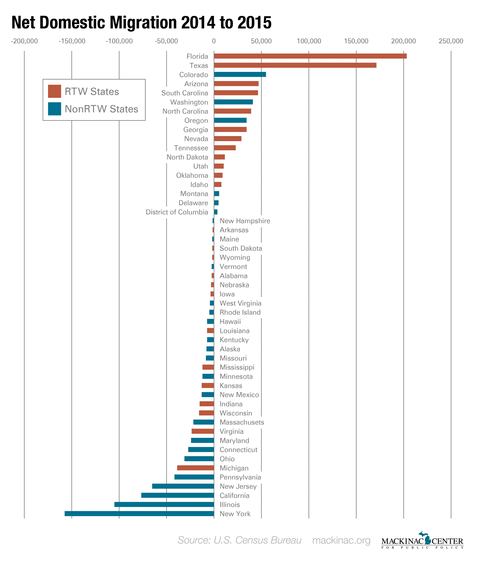Commentary
Americans are Moving to Right-to-Work States
Right-to-work states gain 480,000 people from domestic migration
New numbers from the Census Bureau on how many people move from state to state underscore another aspect of the right-to-work debate that does not often take center stage: Americans continue to move to right-to-work states.
The Mackinac Center has long viewed changes in the number of people in a state as perhaps the single best tool for measuring the quality of life there. After all, there are reasons people pack up and move, and those reasons reflect an individual’s self-interest. Economic opportunities are a clear reason to move, as are amenities such as access to coastal waters or more temperate climates.
According to the Census Bureau, states with right-to-work laws gained a net 480,411 people who moved from non-right-to-work states between July 1, 2014, and July 1, 2015. Granted, few people move to a state specifically because it enjoys right-to-work protections. They do, however, move to states with greater economic opportunities, something which is facilitated by right-to-work statutes.
In his excellent 2010 paper for the Cato Journal, Richard Vedder called the migration of Americans to right-to-work states an “important untold story.” Vedder investigated whether right-to-work had an impact on net migration and — after controlling for other factors, such as climate, taxes, and the types of jobs available in each state — he found that “without exception, in all the estimations, a statistically significant positive relationship … was observed between the presence of right-to-work laws and net migration.” That is, right-to-work states attract more people.
Vedder is not the only scholar to find a link between right-to-work laws and positive population changes. In 2013, I published a study with Mackinac Center adjunct scholar Michael Hicks titled, “Economic Growth and Right-to-Work Laws,” which contained 64 years of data from 48 contiguous states. We found that right-to-work states saw population growth nearly 0.6 percentage points higher than they would have had without a right-to-work law.
Michigan’s population now stands at 9,922,576, the 10th-largest in the United States. Despite being a right-to-work state, Michigan had a net loss of some 39,000 people between July 2014 and July 2015.
If the Michigan Legislature wants to stem further losses, it could turn its attention back to policies that chase citizens away — or even thwart their arrival. Cutting the personal income tax and offsetting any revenue losses with spending cuts would be an obvious place to start.

|

Americans are Moving to Right-to-Work States
Right-to-work states gain 480,000 people from domestic migration
New numbers from the Census Bureau on how many people move from state to state underscore another aspect of the right-to-work debate that does not often take center stage: Americans continue to move to right-to-work states.
The Mackinac Center has long viewed changes in the number of people in a state as perhaps the single best tool for measuring the quality of life there. After all, there are reasons people pack up and move, and those reasons reflect an individual’s self-interest. Economic opportunities are a clear reason to move, as are amenities such as access to coastal waters or more temperate climates.
According to the Census Bureau, states with right-to-work laws gained a net 480,411 people who moved from non-right-to-work states between July 1, 2014, and July 1, 2015. Granted, few people move to a state specifically because it enjoys right-to-work protections. They do, however, move to states with greater economic opportunities, something which is facilitated by right-to-work statutes.
In his excellent 2010 paper for the Cato Journal, Richard Vedder called the migration of Americans to right-to-work states an “important untold story.” Vedder investigated whether right-to-work had an impact on net migration and — after controlling for other factors, such as climate, taxes, and the types of jobs available in each state — he found that “without exception, in all the estimations, a statistically significant positive relationship … was observed between the presence of right-to-work laws and net migration.” That is, right-to-work states attract more people.
Vedder is not the only scholar to find a link between right-to-work laws and positive population changes. In 2013, I published a study with Mackinac Center adjunct scholar Michael Hicks titled, “Economic Growth and Right-to-Work Laws,” which contained 64 years of data from 48 contiguous states. We found that right-to-work states saw population growth nearly 0.6 percentage points higher than they would have had without a right-to-work law.
Michigan’s population now stands at 9,922,576, the 10th-largest in the United States. Despite being a right-to-work state, Michigan had a net loss of some 39,000 people between July 2014 and July 2015.
If the Michigan Legislature wants to stem further losses, it could turn its attention back to policies that chase citizens away — or even thwart their arrival. Cutting the personal income tax and offsetting any revenue losses with spending cuts would be an obvious place to start.
Michigan Capitol Confidential is the news source produced by the Mackinac Center for Public Policy. Michigan Capitol Confidential reports with a free-market news perspective.